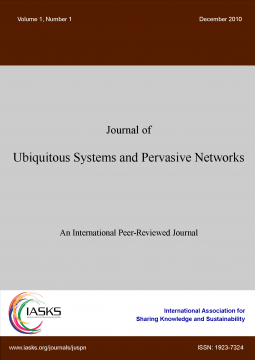volume-11-Issue 1 (2019)
Latest Articles
N Hop a Kind Resource Assignment Method for Optical WDM Networks
JUSPN, volume-11, Issue 1 (2019) , PP 27 - 34
Published: 26 Apr 2019
DOI: 10.5383/JUSPN.11.01.004
by Yashar Fazili, Bill Robertson ,William Phillips from Dalhousie University, Halifax, Canada, B3H 4R2
Abstract: This paper introduces a new resource allocation mechanism for Wavelength Division Multiplexing (WDM) networks. The simple yet effective method introduced in this paper assigns the resources of a dynamically calculated route without needing an optimization solver. By minimizing the number of Lambda conversions at each node using this method, up to 8% more success rate can be achieved compared to assigning the resources using First Fit (FF) with continuity constraint. This method also results in up to 35% less energy usage compared to assigning the resources using First Fit without continuity constraint. The name of N Hop A Kind is after a winning combination of the game of Poker in which a hand with “n of a kind” wins. read more... read less...
Keywords: Resource assignment, WDM, GMPLS, Lambda assignment, Forwarding Plane, Optical
Practical Defense-in-depth Solution for Microservice Systems
JUSPN, volume-11, Issue 1 (2019) , PP 17 - 25
Published: 22 Apr 2019
DOI: 10.5383/JUSPN.11.01.003
by Kai Jander, Lars Braubach, Alexander Pokahr from Brandenburg University of Applied Sciences, City University of Applied Sciences Bremen, Helmut-Schmidt-University
Abstract: Microservices are a widely deployed pattern for implementing large-scale distributed systems. However, in order to harden the overall system and when crossing datacenter boundaries, the authenticity and confidentiality of microservice calls have to be secured even for internal calls. In practice, however, in many cases no internal security mechanisms are employed mainly due to the increased complexity on backend side. This complexity arises as result of standard security mechanisms like TLS requiring secrets for each involved microservice. Building on previous work [19], in this paper we present a novel communication architecture based on roles that on the one hand guarantees a high level of security and on the other hand remains easy to manage. The approach provides encryption, forward secrecy and protection against replay attacks even for out-of-order communication. read more... read less...
Keywords: Microservices, Security, Encryption, Confidentiality, Authentication
A Comparison of LSA and LDA for the Analysis of Railroad Accident Text
JUSPN, volume-11, Issue 1 (2019) , PP 11 - 15
Published: 19 Apr 2019
DOI: 10.5383/JUSPN.11.01.002
by Trefor Williams, John Betak from Rutgers University, New Brunswick, USA, 08854, Collaborative Solutions LLC, Albuquerque, USA, 87122, The University of Texas at Austin
Abstract: Latent Semantic Analysis (LSA) and Latent Dirichlet Allocation(LDA) were used to identify themes in a database of text about railroad equipment accidents maintained by the Federal Railroad Administration in the United States. These text mining techniques use different mechanisms to identify topics. LDA and LSA identified switching accidents, hump yard accidents and grade crossing accidents as major accident type topics. LSA identified accidents with track maintenance equipment as a topic. Both text mining models identified accidents with tractor-trailer highway trucks as a particular problem at grade crossings. It was found that the use of the two techniques was complementary, with more accident topics identified than with the use of a single method read more... read less...
Keywords: railroad, text mining, accidents
Modeling and Verification of Response Time of QoS-aware Web Service Composition by Timed CSP
JUSPN, volume-11, Issue 1 (2019) , PP 01 - 09
Published: 12 Apr 2019
DOI: 10.5383/JUSPN.11.01.001
by Ming Zhu, Xiaoliu Cui, Guodong Fan from College of Computer Science and Technology, Shandong University of Technology, Zibo, China
Abstract: Web service composition enables the provision/reusing of existing services in different business processes to satisfy different business requirements without investing in new infrastructure. QoS-aware web service composition seeks to help users find the optimal solution with maximization of users’ satisfaction. A number of approaches based on Communicating Sequential Processes (CSP) have been proposed to model and verify properties of web service composition. However, little work has been done in verifying inputs, outputs and QoS criteria of web service composition. In this paper, we present a framework to model and verify QoS-aware web service composition by Timed CSP. It helps verify whether the service composition can accept inputs, generate outputs, and meet QoS requirements as specified. To do the verification, transformation rules that map QoS-aware web service composition to Timed CSP are defined. In order to explain the framework and transformation rules, we design a case study, where the model of QoSaware web service composition is transformed to the model of process composition in Timed CSP and the program in machine-readable CSP (CSPM). Furthermore, experiments are performed by using the Failure Divergence Refinement (FDR) tool to verify inputs, outputs, and QoS of the service composition. read more... read less...
Keywords: QoS, service composition, Timed CSP, FDR.

